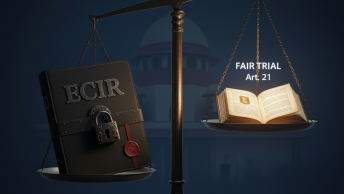Introduction
On 29th December 2021, a Single Bench of the High Court of Jammu & Kashmir [“J&K High Court”] quashed the detention order of Umar Fayaz Mir on the ground that all documents relied upon by the detaining authority were not supplied to Mir. The court held that the right to make an effective and meaningful representation against detention was infringed. While on the face of it, the judgment looks like a routine order in a habeas corpus petition, the length of time taken by the High Court to decide the petition, renders the remedy hollow. In this article, by analyzing the daily orders of Umar Fayaz Mir’s case, I argue that the unreasonable delay caused by the High Court is because of the lackadaisical attitude of the Government. I further point out that such a delay is not an aberration but forms a part of a larger trend of delay by constitutional courts in deciding habeas corpus petitions. Lastly, I suggest a few procedures that the Court can adopt to solve this problem.
Delay in Umar Fayaz Mir’s Case
The Jammu & Kashmir Public Safety Act, 1978 [“PSA”] is a law authorizing preventive detention, applicable in Jammu and Kashmir. It provides for a maximum detention of two years in case of persons acting in any manner prejudicial to the state [Section 18(1)(b)]. In the present case, since the detention order was passed to prevent the detainee from acting in any manner prejudicial to the maintenance of public order, the maximum period would have been twelve months [Section 18(1)(a)]. The power to pass such an order, in both circumstances, can be exercised by either the Divisional Commissioners or the District Magistrates [Section 8(2)]. The judgment records that the detention order was passed on 8 January, 2021 and the case status (WP (Crl) 26/2021) shows that the case was registered on 24 March, 2021. The total time taken to quash the detention order was 355 days (11 months and 21 days) and the High Court took 280 days (9 months and 5 days) to dispose of the petition. Therefore, the High Court’s intervention was too little too late, since the matter was on the verge of becoming infructuous and the detainee would have anyway been released.
Setting a timeline for itself, the J&K High Court has stipulated in its Case Flow Management Rules of 2010 [“the Rules”] that a habeas corpus petition must be made returnable within 48 hours after its first listing. After notice, it must be listed on the fourth working day and if a detailed inquiry is needed, one week and three days’ time should be given to file a rejoinder. All in all, it states that the petition must invariably be disposed within 15 days and would be prioritized over and above fast-track cases. In the present case, since the judgement does not engage with the delay at all, I refer to the order-sheets uploaded on the e-courts website to determine what took the High Court close to a year in disposing off the case. There are 10 orders uploaded on the website (A detailed tabular representation is available here).
In Umar Fayaz Mir’s case, the state can be held particularly accountable for the delay because of the sheer amount of time it sought to file a reply and appear in the case. The deviation from the framework set out in the Rules began on the very first date when the Government was given 3 weeks’ time (instead of 48 hours) to answer the notice issued by the Court (Order dt. 25-03-2021). Thereafter, failing to file a counter-affidavit in 3 weeks, the Court gives another 4 weeks’ time to the state (Order dt. 15-04-2021). When the petition comes up for final hearing for the first time, the state fails to even appear before the Court and consequently, the case is again adjourned for another 3 weeks (Order dt. 14-07-2021). The petitioner in the present case even expressed urgency on one occasion (Order dt. 07-10-2021), and declined to file a rejoinder, possibly in the hope of expediting the hearing.
An unreasonable delay is particularly fatal in a case of preventive detention because of the unchecked powers the executive enjoys. The person is kept in a jail (Mir was even shifted out of his home State to a jail in Haryana) without any legal representation and without an order from a Magistrate authorizing their detention. Umar Fayaz Mir’s case forms a part in a larger trend of delays by Constitutional Courts in hearing habeas corpus petitions; a problem which has serious and direct consequences to the personal liberty of an individual.
Delays by Constitutional Courts
On numerous occasions, Courts have termed the law of preventive detention as the ‘jurisdiction of suspicion’. That is to say, the basis of preventive detention is not the guilt of the detainee but the suspicion in the minds of the detaining authority. Since the Courts cannot supplant this subjective satisfaction, it becomes imperative that the minimum procedural safeguards prescribed are strictly followed. In India, while the law on preventive detention was introduced under considerable resistance, at a time when violence was rampant, its use and scope have only expanded.
Shrimoyee Ghosh and Haley Duschinski argue that the use of preventive detention law in Jammu and Kashmir has preserved a state of constant emergency marred by hyper legal procedures and an endless bureaucratic trail of paperwork. The system works with the aim of keeping political dissidents permanently out of circulation, presumably, by either putting back-to-back PSA detention orders, delaying adjudication of the legality of detention orders (like in Mir’s case), or the State choosing to keep the case in limbo by not filing a counter-affidavits at all. An empirical analysis of habeas corpus cases at the J&K High Court in 2019 showed that on an average, the Court took 232 days to dispose of a petition. In this broader context, the delay in deciding the habeas corpus petitions helps the state in keeping detainees under illegal detention long enough to achieve its objective – of keeping dissidents out of public life – with impunity. In such a situation, an unreasonable delay by the Court (a little over 9 months in Mir’s case) in deciding the legality of the detention dilutes the mandate set out in Article 21 of the Constitution and unfairly restricts the personal liberty of an individual. Specifically, the delay causes irretrievable damage to the personal liberty of an individual for which no one can be held accountable for.
Research also suggests that this is not a High Court-specific problem. An empirical study conducted by Shrutanjaya Bhardwaj analysing habeas corpus petitions disposed by the Supreme Court from 2000-2019 finds that, on an average, the Supreme Court takes 953 days to give its decision. This timeframe is more than the maximum period prescribed for detention (generally one year) in most legislations. As a result, the delay reduces the writ of habeas corpus to a meaningless remedy since the detainee would anyway be released, regardless of the Court’s ruling on the legality of the detention order. For example, in Union of India v. Paul Manickam, the detenu had undergone the whole period of detention by the time the High Court quashed the detention order. Nevertheless, the Supreme Court decided the case since it involved important questions of law (See Para 4-6). Similarly, in Chakravarthy v. State of T.N., even though the maximum period of detention had lapsed the Court decided the case on the insistence of the detenu’s counsel.
The High Court, being the first forum in a habeas corpus petition against illegal detention, has a larger burden to dispose of the case expeditiously to leave space for a situation where it might be appealed further. In at least two occasions (see here and here) the Supreme Court nudged the High Courts to prioritise disposal of the matters relating to personal liberty in cases where the preventive detention is for one year or less. More particularly, in a judgment delivered by Madras High Court, the Court deprecated the practice of taking multiple adjournments to file a counter affidavit by the detaining authority in habeas corpus petitions. It observed that expedited disposal of the representation of the detenu is equally applicable to expeditious disposal of habeas corpus petitions. Thus, the J&K High Court is no exception when it comes to delays in disposing of habeas corpus petitions and Umar Fayaz Mir’s case is just a continuation of a familiar pattern.
What can the Court do?
In the case of Umar Fayaz Mir, even though the state can be held responsible for the delay, ultimately it is the Court that routinely allows large amounts of time to the State to fulfill simple procedures. The primary and the most important suggestion would be to follow the Case Flow Management Rules in letter and spirit to dispose of habeas corpus petitions as soon as possible.
Secondly, the Court enjoys expansive powers under Article 226; if it is of a prima facie view that the detention order is patently illegal, it can release the detenu (in the nature of bail) as an interim relief until it finally decides on the legality of the order (See State of Bihar v. Rambalak Singh, Para 9). An additional suggestion would be that the Court can explore the option of passing an order to release the detenu when it reserves judgment or soon thereafter, and give detailed reasons later in support of it (For an example, see Lallubhai Jogibhai Patel v. Union of India).
Lastly, in a case where the respondent authorities fail to file a written counter-affidavit, the Court should proceed to determine the legality of the Order. In consonance with the spirit of the Rules, the Authorities must not be allowed more than a week to reply to the petition. And in case of failure on their part, only the oral arguments must be accepted, if necessary. (The J&K HC has proceeded to pronounce judgments where a written affidavit was not filed after multiple opportunities. See, here, here and here).
Conclusion
As Umar Fayaz Mir’s case indicates, even though the authorities should be held accountable for the delay, neither the state nor the Court seemed to express any urgency in deciding the matter. Despite enumerating the urgency a habeas corpus petition requires in its Case Flow Management Rules, the High Court continues to take an unreasonable time in deciding matters of preventive detention. By its very nature, preventive detention requires procedure to be minimized. Therefore, a delay in deciding the legality of a detention order, not only has serious consequences on personal liberty but also gives the executive impunity in misusing the stringent law.
Varun Ahuja is a fourth-year BA LLB student at Vivekananda Institute of Professional Studies, Delhi. He is interested in reading and writing about criminal and constitutional law.







